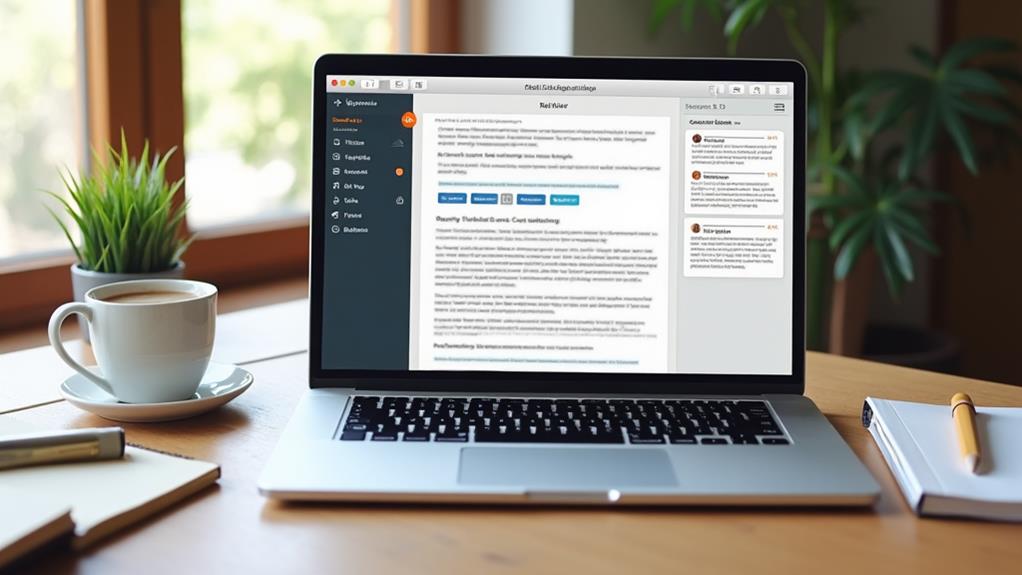
Crafting SEO-friendly blog posts is essential for enhancing visibility and driving targeted traffic. Start by understanding your audience through tools like Google Analytics and competitor analysis. Conduct thorough keyword research to identify high-volume, low-competition terms that align with user intent. Create compelling headlines, use clear structure with heading tags, and focus on long-tail keywords. Writing high-quality, original content of at least 600 words and optimizing title tags and meta descriptions improves search rankings. Enhance readability with concise paragraphs, internal linking, and multimedia elements. Regularly updating your blog based on performance analytics guarantees sustained relevance and engagement. Explore these strategies further for extensive insights.
Key Takeaways
- Conduct thorough audience research using tools like Google Analytics to tailor content to your readers' preferences.
- Utilize keyword research tools such as Google Keyword Planner to identify high-volume, low-competition keywords.
- Craft compelling headlines incorporating target keywords to boost click-through rates and search engine rankings.
- Structure blog posts with clear headings, concise paragraphs, and bullet points to enhance readability and SEO.
- Optimize title tags and meta descriptions with target keywords for improved visibility and user engagement.
Understanding Your Audience
Understanding your audience is a foundational step in crafting SEO-friendly blog posts that not only attract readers but also engage them effectively. Conducting thorough research is essential to identify your audience's needs, preferences, and pain points.
Utilizing tools like Google Analytics and social media insights can provide valuable data on audience behavior and demographics, thereby enabling precise audience segmentation. By creating detailed buyer personas, you can tailor your content strategy to address the specific interests of different segments within your target audience.
Engagement is key to understanding your audience's evolving expectations. Actively seeking user feedback through comments, surveys, and social media interactions offers real-time insights that can refine your content approach.
This engagement fosters a deeper connection with your audience, ensuring that your blog remains relevant and valuable. Regular updates and strategic keyword placement in your content can further enhance your blog's SEO performance and keep it aligned with audience interests.
Additionally, analyzing competitors' content and their audience engagement strategies can uncover gaps in your own approach, offering opportunities for improvement.
Importance of Keyword Research
Building on the insights gained from understanding your audience, keyword research emerges as a vital component in creating SEO-friendly blog posts. By identifying the search terms and phrases your target audience uses, keyword research allows you to craft content that is both relevant and valuable.
Utilizing tools like Google Keyword Planner and SEMrush can reveal high-volume, low-competition keywords, positioning your blog posts for maximum visibility in search results. Additionally, incorporating long-tail keywords can greatly improve your content's visibility and conversion rates.
A thorough competitor analysis can uncover content gaps, providing opportunities for niche targeting and keyword clustering. Understanding search intent is essential; long-tail keywords, which are more specific phrases, often align closely with user intent and can drive targeted traffic, resulting in higher conversion rates.
Regularly updating your keyword strategy based on keyword trends and analytics guarantees your content remains relevant in the ever-evolving search landscape. Effective keyword placement within headings, meta descriptions, and throughout your content not only enhances SEO performance but also improves readability.
Crafting Engaging Headlines
Creating compelling headlines is an essential aspect of crafting SEO-friendly blog posts, as it directly influences both click-through rates and search engine rankings. Effective headlines should ideally be 55-70 characters long to guarantee full display in search results, maximizing visibility and attracting more clicks.
Incorporating target keywords at the beginning of your headlines enhances SEO visibility and relevancy, making it easier for search engines to index your content. Additionally, consider how your headline aligns with your profitable niche to make sure it resonates with your target audience.
Using proven headline formulas, such as "How to" or "Top X," can greatly engage readers. These headline examples have been shown to increase click-through rates by providing clear value propositions.
Additionally, making your headlines descriptive and intriguing is imperative. Employing emotional triggers or posing questions can captivate readers, encouraging them to click and explore further.
A/B testing different headline variations allows you to identify which ones yield the highest engagement rates. By analyzing performance data, you can refine your approach and consistently craft headlines that resonate with your audience.
Combining these strategies guarantees that your headlines are not only SEO-friendly but also compelling enough to drive traffic to your blog posts.
Structuring Your Blog Post
Structuring your blog post with a clear introduction, body, and conclusion is essential for enhancing readability and improving SEO.
Utilizing effective heading tags such as H1 for the title and H2 for main sections not only organizes information but also signals keyword importance to search engines.
Keeping paragraphs concise and incorporating bullet points and numbered lists can greatly increase reader engagement and comprehension.
Additionally, consider integrating visual storytelling techniques to create emotionally resonant content that captivates your readers.
This approach, combined with SEO best practices, can greatly improve your blog's performance and audience retention.
Clear Paragraph Structure
A well-defined paragraph structure is essential for crafting SEO-friendly blog posts that captivate readers and improve search engine rankings. By focusing on paragraph coherence and employing readability techniques, you can create content that is both engaging and easy to digest. Each paragraph should be limited to 2-4 sentences, ensuring that readers can absorb the information without feeling overwhelmed.
For ideal clarity and coherence, each paragraph should center around a single idea or concept. This approach maintains the logical flow of your blog post and prevents confusion. Utilizing connecting words at the beginning of paragraphs is another effective readability technique, guiding readers smoothly from one point to the next.
To further enhance engagement and comprehension, consider breaking up text with subheadings and bullet points within paragraphs. This format not only makes your content more skimmable but also highlights key information. Additionally, consistent use of formatting techniques like bolding key terms helps emphasize important points and retains readers' attention.
- Limit paragraphs to 2-4 sentences
- Focus each paragraph on a single idea
- Use connecting words to improve flow
- Break up text with subheadings and bullet points
Implementing these strategies will greatly enhance the readability and effectiveness of your blog posts.
Effective Heading Usage
Utilizing effective heading usage is vital for structuring your blog post in a way that maximizes both reader engagement and SEO performance. A clear heading structure, consisting of H1, H2, and H3 tags, organizes content effectively, enhancing readability and aiding search engines in understanding the SEO hierarchy of information.
By incorporating target keywords naturally within these headings, you improve SEO visibility. Positioning keywords towards the beginning of your headings can lead to better impact in search engine results.
Concise and descriptive titles should be your goal, with a recommended length of 55-70 characters to avoid truncation in search results. Such precision not only engages readers but also guarantees your content is easily scannable.
Subheadings (H2, H3) play an important role in breaking up text, guiding readers through the content and allowing them to locate relevant information quickly.
Incorporating linking words in your headings enhances the flow and coherence of your blog post. This technique helps guide readers through the structure seamlessly, contributing to overall heading effectiveness.
Writing High-Quality Content

Creating high-quality content is foundational to any successful SEO strategy, as it not only enhances search engine rankings but also drives meaningful engagement from your audience.
High-quality content should be at least 600 words long to maximize SEO benefits and reader engagement, with longer articles typically performing better in search rankings. Prioritizing content originality is essential; unique and insightful content that addresses your audience's needs and questions can greatly improve reader retention and encourage social sharing.
This involves ensuring mobile responsiveness and user-friendly navigation, which are vital for enhancing user experience and SEO.
To craft content that resonates with your audience and boosts SEO:
- Use concise sentences and bullet points: Enhances readability, allowing readers to quickly grasp key information.
- Incorporate multimedia elements: Adding images and videos enriches the content, increasing the likelihood of user engagement.
- Regularly update content: Revamping existing articles with new information or insights can improve relevance and maintain or boost search engine rankings.
- Analyze audience needs: Tailor your content to address specific questions and interests, fostering deeper audience engagement.
Using Long-Tail Keywords
Incorporating long-tail keywords into your blog posts is a strategic approach that can greatly enhance your SEO efforts by targeting specific search queries that are less competitive and more aligned with user intent.
Long-tail keywords, typically consisting of three or more words, offer significant long tail benefits, such as increased chances of ranking higher in search engine results and attracting more qualified traffic. Research indicates that long-tail keywords can account for up to 70% of all search traffic, underscoring their importance in a thorough SEO strategy.
Additionally, focusing on long-tail keywords can help you attract highly targeted traffic, a vital aspect of ecommerce success.
Effective keyword placement is vital for maximizing the benefits of long-tail keywords. Integrating these keywords naturally within your content, headings, and meta descriptions can improve your blog's visibility and relevance.
Tools like Google Keyword Planner and SEMrush are invaluable for identifying high-impact long-tail keywords that resonate with your target audience's search behavior.
Additionally, long-tail keywords often lead to higher engagement rates. By matching niche topics closely related to specific user interests, they result in lower bounce rates and increased time on page.
This alignment with user intent not only enhances user experience but also boosts conversion rates, making long-tail keywords an essential component of your SEO toolkit.
Optimizing Title Tags

Optimizing title tags is a essential element in enhancing your blog's SEO performance, as these tags serve as the first impression for both search engines and users. Adhering to title tag best practices can greatly impact your blog's visibility and user engagement.
One important practice is ensuring your title tags are between 55-70 characters to prevent truncation in search results. This not only aids in readability but also maintains the integrity of your message.
Additionally, leveraging sophisticated data visualization can help you understand how different title tags perform in search results. Incorporating the target keyword at the beginning of the title tag can further improve its visibility and relevance.
By optimizing click-through rates (CTR), you can entice users to choose your link over competitors. Crafting descriptive and compelling title tags is essential for this purpose.
Unique title tags for each page or post are necessary to avoid duplicate content issues, which could harm your SEO performance. Furthermore, your title tags should accurately reflect the page content to build trust and reduce bounce rates.
Key points to remember:
- Character Length: Keep title tags between 55-70 characters.
- Keyword Placement: Start with your target keyword for better visibility.
- Compelling Descriptions: Use engaging language to boost CTR.
- Uniqueness: Avoid duplicate titles across your blog.
Creating Meta Descriptions
Crafting a compelling meta description is an art that combines both precision and creativity. A well-executed meta description, ideally between 150-160 characters, serves as a concise summary of your blog post, enticing users to click through to your content.
Effective meta description examples often include target keywords to improve visibility in search results. However, it is essential to maintain a natural reading flow and avoid keyword stuffing, which can detract from the user experience.
Incorporating action-oriented language in your meta descriptions can greatly enhance user engagement. Phrases such as "discover," "learn," and "explore" prompt readers to take specific actions, boosting your click-through rates (CTR). For instance, "Discover the ultimate guide to writing SEO-friendly blog posts" can be more compelling than a generic description.
Additionally, leveraging behavioral insights can help tailor your meta descriptions to your audience's preferences, further increasing engagement.
Regularly updating your meta descriptions is another strategy to maintain relevance and improve SEO performance. As search trends and audience interests evolve, revitalizing your meta descriptions guarantees that they remain aligned with current user queries and expectations.
Proper Use of Headings

Having mastered the art of creating compelling meta descriptions, the next step in writing SEO-friendly blog posts involves the proper use of headings. Utilizing a clear heading hierarchy (H1, H2, H3) helps organize content, making it easier for readers to navigate and understand the main points of the article.
Search engines prioritize headings in their algorithms, so incorporating relevant keywords within them can greatly improve SEO by signaling the topic's relevance.
Well-structured headings enhance user engagement by making the content accessible and easy to skim through. Additionally, clear navigation paths created by headings can reduce bounce rates, akin to well-organized menus on ecommerce websites.
To fully capitalize on the benefits of well-structured headings:
- Maintain a unique H1 tag: Confirm each post has a distinct H1 to emphasize its unique subject matter.
- Optimize heading length: Keep headings concise yet descriptive to enhance readability and SEO effectiveness.
- Use H2 and H3 for subtopics: This creates a logical flow and maintains content coherence, facilitating better user engagement.
- Enhance scannability: Well-structured headings aid readers in skimming through articles, helping them find key information quickly.
Research shows that articles with a well-defined heading hierarchy achieve higher engagement rates.
Image Optimization Techniques
Image optimization techniques are essential for enhancing SEO performance and user experience.
Utilizing descriptive image alt text helps search engines understand the content and context, while compressing images to reduce file size can greatly improve page load speed.
Additionally, incorporating relevant keywords in your image file names and captions can further boost search visibility.
Descriptive Image Alt Text
Descriptive image alt text plays a vital role in SEO strategies, serving as an essential component that provides search engines with valuable context about the content of images. By adhering to effective alt text guidelines, bloggers can considerably enhance their site's search visibility and user experience.
Including target keywords in image descriptions is a proven method to improve search rankings. However, it is important to prioritize natural language usage to avoid keyword stuffing, which can negatively impact SEO. Alt text should ideally be concise yet descriptive, ranging between 100-125 characters, to convey the image's purpose and content effectively to both search engines and visually impaired users.
Properly optimized alt text can yield multiple benefits:
- Improved search visibility: Enhances the likelihood of images appearing in relevant search queries.
- Better user experience: Provides meaningful descriptions when images fail to load.
- Accessibility: Assists visually impaired users in understanding image content through screen readers.
- Increased traffic: Boosts rankings in image search results, driving more visitors to your blog.
Incorporating these alt text guidelines into your blogging strategy guarantees that your images contribute positively to your site's SEO, ultimately leading to better overall visibility and engagement.
Image Compression Techniques
Optimizing images through effective compression techniques is crucial for enhancing page load speed and overall user experience, which are critical factors for SEO rankings.
Image compression techniques reduce file size without greatly sacrificing quality, thereby improving page speed and user engagement. Two primary methods are lossless compression and lossy compression. Lossless compression retains all original image data, preserving visual fidelity and making it ideal for high-quality image filetypes. Conversely, lossy compression achieves considerable file size reductions by removing some data, which can still be acceptable for web use.
Compression tools like TinyPNG and JPEGmini are invaluable for maintaining visual fidelity while achieving up to 80% file size reduction. Proper file naming with descriptive keywords further enhances SEO by helping search engines understand image content, thereby improving visibility in image search results.
Implementing responsive images using the "srcset" attribute guarantees that the appropriate image size is delivered based on the user's device, optimizing both performance and user experience.
Internal Linking Strategies

Crafting an effective internal linking strategy is essential for elevating your website's SEO performance. By connecting existing content, you improve site navigation and help search engines understand the relationship between different pages, thereby enhancing overall SEO benefits.
To maximize the effectiveness of your internal links, consider the following linking best practices:
- Anchor Text Optimization: Utilize descriptive anchor text to improve keyword relevance and assist search engines in indexing your content properly.
- Content Hierarchy: Confirm that your internal links reflect the structure of your content, guiding users through a logical flow that enhances user experience.
- Contextual Relevance: Place links where they naturally fit within the content, maintaining a balance to avoid appearing spammy while still improving crawl efficiency and content interconnectivity.
- Linking Frequency: Regularly publish high-quality content to create more opportunities for internal linking, thereby building a robust web of connections that enhances content discoverability.
Enhancing Readability
Enhancing readability in your blog posts is essential for both SEO and user engagement.
Implementing a clear heading structure with H1, H2, and H3 tags not only improves navigation but also boosts search engine visibility.
Additionally, maintaining short paragraphs and strategic line breaks guarantees that readers stay focused and engaged, ultimately enhancing the overall user experience.
Clear Heading Structure
A clear heading structure serves as the backbone of an SEO-friendly blog post, greatly enhancing readability and user engagement. By using a proper heading hierarchy, such as H1 for the title and H2/H3 for subheadings, you not only organize your content but also boost SEO.
This systematic content organization allows search engines to better understand the hierarchy of your information, thereby improving your chances of ranking higher for targeted keywords.
Incorporating keywords within your headings can signal to search engines what your content is about, further improving SEO performance. Additionally, well-structured headings considerably enhance readability, allowing readers to quickly scan and navigate through your blog post.
This can lead to increased engagement and lower bounce rates, as users are more likely to find and focus on the sections that interest them. Research underscores that a clear heading structure can greatly improve user experience and retention.
To achieve a clear heading structure:
- Use H1 for the main title and H2/H3 for subheadings.
- Integrate relevant keywords into your headings.
- Utilize bullet points and numbered lists for clarity.
- Verify headings accurately reflect the content of their sections.
Short Paragraphs and Line Breaks
To enhance readability and retain user engagement, employing short paragraphs and line breaks is essential.
Ideal paragraph length, consisting of 2-4 sentences, improves comprehension and keeps readers more engaged with your content. This text formatting technique not only enhances reader engagement but also greatly boosts content readability.
Line breaks between paragraphs create visual appeal by introducing white space, which makes the content appear less intimidating and easier to digest.
Research indicates that content formatted with shorter paragraphs can increase reading speed by up to 20%. This improvement in readability often translates to higher information retention, as readers can more easily process and remember the content.
Additionally, utilizing line breaks and short paragraphs can help reduce bounce rates.
Readers are more likely to stay on the page when the text is presented in manageable chunks, thereby improving overall user experience. This is particularly vital for mobile optimization, where users prefer concise, easily scannable content on smaller screens.
Utilizing Multimedia

Incorporating multimedia elements such as images, videos, and infographics into your blog posts can greatly enhance reader engagement and retention. Studies show that articles with visuals receive 94% more views than those without. By leveraging multimedia storytelling, you can create interactive content that captivates your audience.
Optimize images with descriptive file names and alt text to boost SEO and improve accessibility considerations. Video integration can notably increase the average time visitors spend on a page, contributing to a 157% rise in organic traffic for websites featuring video content.
Utilizing multimedia effectively includes:
- Infographic design: Simplify complex data, making it more digestible and shareable. Blog posts with infographics are shared three times more on social media.
- User-generated visuals: Encourage readers to contribute their own photos or videos, fostering a sense of community and engagement.
- Audio elements and presentation slides: Cater to different learning styles and preferences by incorporating varied content formats.
- Visual branding: Maintain consistent visual elements to strengthen brand identity and make your content more recognizable.
Additionally, consider content repurposing by transforming blog posts into other formats such as videos or infographics. This not only extends the lifespan of your content but also caters to a wider audience.
Regular Content Updates
Regularly updating your blog content is essential for maintaining relevance, boosting search visibility, and enhancing reader engagement.
Search engines favor active websites, and keeping your content current with fresh information can greatly improve SEO performance.
A consistent update schedule, coupled with incorporating audience feedback, guarantees your blog remains accurate, engaging, and highly ranked.
Maintaining Content Relevance
A well-maintained blog is vital for sustaining high search engine rankings and audience engagement. Regular content updates signal to Google that your website is active, which can greatly enhance search visibility.
To maintain content relevance, it is important to conduct regular content audits and seasonal updates. This practice guarantees your blog remains aligned with current trends and audience interests.
Implementing a consistent update schedule, such as quarterly or biannually, guarantees accuracy and value across your content. Employ analytics to pinpoint underperforming posts for targeted updates, thereby boosting traffic and improving site authority.
Key strategies for maintaining content relevance include:
- Content Audits: Regularly review and update existing posts to keep information current and valuable.
- Seasonal Updates: Refresh content to reflect seasonal trends and events, capturing timely audience interest.
- User Feedback: Incorporate reader questions and feedback to deepen topic exploration and enhance engagement.
- Analytics-Driven Revisions: Use data to identify and improve underperforming posts, boosting overall content quality and relevance.
Boosting Search Visibility
To enhance your website's search visibility, consistently updating your content is paramount. Regular content updates signal to search engine algorithms that your website is active and relevant, which can positively influence your rankings and visibility in search results.
Studies have shown that updating old blog posts with fresh information can increase organic traffic by as much as 111%. This is because content freshness attracts more visitors, making your site more appealing to both users and search engines.
Search engines favor websites that continually provide new content; maintaining a consistent posting schedule can lead to a significant increase in search visibility—up to 30%. By integrating recent trends or changes in your industry into existing posts, you enhance their relevance, making them more likely to appear in search results for related queries.
This not only helps in maintaining content freshness but also in aligning with search engine algorithms that prioritize up-to-date information.
Furthermore, regularly updated content helps improve your site's authority, keeping your audience engaged and returning for more. By updating your content every few months, you can guarantee that your website remains a valuable resource, thereby boosting your search engine rankings and overall visibility.
Enhancing Reader Engagement
Maintaining a consistent posting schedule not only boosts search visibility but also plays an essential role in enhancing reader engagement. Regularly updating blog content signals to search engines that the site is active, which can positively impact rankings.
More importantly, fresh content entices readers to return, fostering a loyal audience. HubSpot's study reveals that companies consistently updating their blogs attract 55% more website visitors, highlighting the critical role of content freshness.
To effectively enhance reader engagement, consider the following strategies:
- Interactive Elements: Incorporate polls, quizzes, or comment sections to encourage active participation and gather valuable audience feedback.
- Content Updates: Regularly refresh old posts with new data or perspectives to maintain relevance and drive traffic.
- Editorial Calendar: Use an editorial calendar to schedule updates, ensuring content remains current and aligned with seasonal trends or evolving audience interests.
- Social Media Integration: Share updated content on social media platforms to increase visibility and encourage sharing.
Tracking Performance With Analytics
Leveraging analytics is essential for understanding the effectiveness of your blog posts and refining your content strategy. Utilizing performance metrics through robust analytics tools like Google Analytics provides invaluable insights into user behavior.
By monitoring key indicators such as bounce rate, average session duration, and pages per session, you can gauge how well your content resonates with your audience. Data visualization in these tools aids in simplifying complex data, making it easier to identify trends and areas for content optimization.
Setting up conversion tracking and specific goals, such as newsletter sign-ups or product purchases, enables you to measure the direct impact of your blog posts on your business objectives. Identifying traffic sources is vital as it reveals where your audience is coming from and helps tailor your content to maximize reach.
Engagement analysis through audience segmentation allows you to understand different user groups and their interaction with your content. Regularly analyzing keyword performance with Google Search Console helps refine your SEO strategy, ensuring you target the right search terms.
Implementing A/B testing for headlines and calls to action can further enhance click-through rates, ultimately leading to better-informed content strategies and higher engagement.
Frequently Asked Questions
How to Write a SEO Friendly Blog Post?
To write an SEO-friendly blog post, conduct thorough keyword research, and establish a clear content structure with headings. Craft engaging, high-quality content that addresses audience needs, and optimize on-page elements to enhance visibility and click-through rates.
What Is the Best Way to Optimize a Blog Post for SEO?
The best way to optimize a blog post for SEO is through meticulous keyword research and strategic content structure, ensuring long-tail keywords are naturally integrated and headings are effectively utilized to enhance readability and improve search engine rankings.
How Do You Write a SEO Description for a Blog Post?
To write an effective SEO description, conduct thorough keyword research to identify relevant terms. Incorporate the primary keyword within the first 100 characters of the meta tags, use engaging language, and avoid duplicates to enhance search engine visibility.
How Many Words Should My Blog Post Be for SEO?
For ideal SEO, the perfect length of a blog post ranges between 1,000 to 2,000 words. Prioritize content quality and relevance, as these factors greatly enhance search rankings and reader engagement, beyond merely meeting word count targets.
Conclusion
In summary, understanding the target audience, conducting thorough keyword research, and crafting engaging headlines are vital for writing SEO-friendly blog posts. Structuring content effectively, maintaining high-quality writing, enhancing readability, and incorporating multimedia elements contribute to improved user experience and search engine rankings. Regular updates and performance tracking through analytics are fundamental for sustained success. Implementing these strategies guarantees optimized content that resonates with the audience and achieves desired SEO outcomes.
Leave a Reply